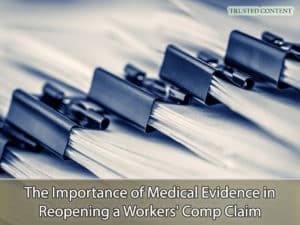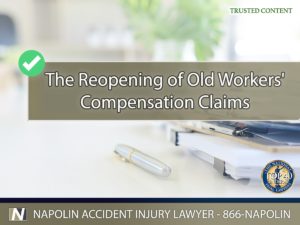Navigating the Reopening of Old Workers’ Compensation Claims in Ontario, California

Understanding California Workers’ Compensation Claim Reopening
In the intricate landscape of workers’ compensation in California, the opportunity to revisit and reopen old claims presents a vital recourse for those whose injuries evolve over time. This complex process, governed by stringent legal stipulations, demands a nuanced understanding of the conditions under which a claim can be reopened. It serves not just as a legal procedure but as a lifeline for many who find their initial injuries have given way to more severe or unforeseen medical complications. The law in California is designed to accommodate these changes, ensuring that workers are not left to bear the burden of worsened conditions without support. This article aims to demystify the process, offering clarity and guidance on how to navigate these waters effectively.
Understanding California Workers’ Compensation Claim Reopening
California’s legislative framework, particularly the Labor Code § 5410, provides a window of five years from the date of the original injury for individuals to reopen their workers’ compensation claim. This provision underscores the state's acknowledgment that some injuries deteriorate over time or lead to secondary conditions that were not apparent or fully developed at the time of the initial claim. The ability to reopen a claim is contingent upon proving that the injury has indeed worsened or that new medical issues have arisen as a direct consequence of the original injury.
Eligibility Criteria for Reopening a Claim
To be eligible for reopening a claim, claimants must meet specific criteria that substantiate the worsening of their condition or the emergence of new health issues related to the original injury. This includes demonstrating through medical evidence that there has been a significant change in their health status, necessitating further medical treatment or adjustment of the benefits previously awarded. For example, an injury that was initially thought to be fully resolved but has since led to chronic pain or reduced mobility would qualify. The law seeks to balance the need for finality in workers’ compensation claims with the reality that some injuries have delayed or progressive consequences not fully appreciated at the time of the original settlement.
Navigating the Petition Process
The process of petitioning to reopen a workers’ compensation claim involves several critical steps, beginning with the gathering of necessary medical evidence. Following this, claimants must complete and submit specific forms available through the California Department of Industrial Relations (DIR) and the Division of Workers’ Compensation (DWC). These forms require detailed information about the original injury, the basis for reopening the claim, and the new medical evidence supporting the petition. The complexity of the process is compounded by the need to adhere to specific procedural rules and deadlines, making navigation without guidance challenging. This segment underscores the procedural hurdles and emphasizes the value of expert assistance in ensuring a petition is accurately and comprehensively filed.

The Importance of Medical Evidence in Reopening a Workers' Comp Claim
The Importance of Medical Evidence in Reopening a Workers' Comp Claim
The bedrock of any petition to reopen a workers’ compensation claim is the medical evidence presented to support the claim of worsened conditions. This evidence must convincingly link the original workplace injury to the current health issues. The type of documentation required includes, but is not limited to, detailed medical reports, diagnostic tests (such as X-rays and MRIs), treatment records, and expert testimony from healthcare providers. This documentation plays a dual role: it validates the existence of a worsened condition or new medical issue and establishes its direct connection to the workplace injury. Collecting and presenting this evidence can be a daunting task, underscoring the importance of seeking legal and medical advice.
Legal Representation: Your Ally in the Process
Engaging with an attorney experienced in California’s workers’ compensation laws is not merely beneficial but often essential for the successful reopening of a claim. A skilled lawyer can provide invaluable assistance at every stage of the process, from evaluating the viability of a petition to gathering and presenting compelling medical evidence. Legal representation becomes particularly critical when facing the procedural and evidentiary challenges of the petition process. Moreover, an attorney can negotiate on behalf of the claimant, ensuring that their rights are protected and that they receive the full benefits to which they are entitled under the law.
The Road Ahead: Post-Petition Considerations
After a petition to reopen a workers’ compensation claim is filed, several outcomes are possible. If the petition is successful, it may result in an adjustment of benefits, additional medical treatment coverage, or other modifications to the original award. However, if the petition faces denial, claimants have the right to appeal the decision, a process that involves presenting the case in front of the Workers’ Compensation Appeals Board. This stage of the process demands a thorough preparation and a compelling argument to overturn the initial decision. The journey from petition to resolution is complex and fraught with legal nuances, making the guidance of a knowledgeable attorney indispensable.

Navigating the Reopening of Old Workers' Compensation Claims in Ontario, California
Navigating the Reopening of Old Workers' Compensation Claims in Ontario, California
Reopening an old workers’ compensation claim in California offers a critical avenue for individuals facing the long-term effects of workplace injuries. While the process is intricate and laden with legal complexities, understanding the steps involved and securing the right support can make a significant difference. For those contemplating this path, consulting with Napolin Accident Injury Lawyer at (909) 962-8415 presents an essential first step. With extensive experience in workers’ compensation law, our firm is dedicated to guiding clients through the process, ensuring their rights are upheld, and advocating for the benefits they rightfully deserve.
